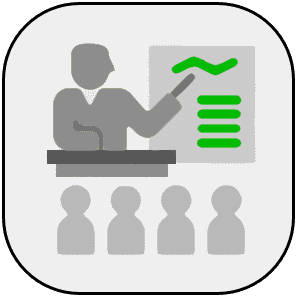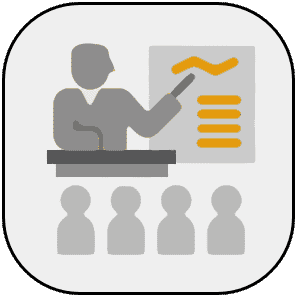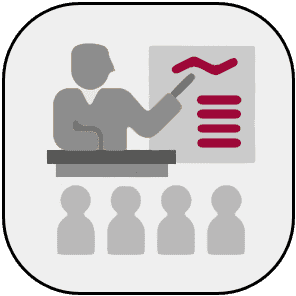What are CSFs and KPIs?

CSFs and KPIs are techniques that were pioneered by D. Ronald Daniel
and Jack F. Rockart. They can be used for defining and measuring
business objectives.
CSF is an acronym for Critical Success Factor. KPI is an
acronym for Key Performance Indicator. Both of these words are widely
used in the context of the design of relevant aims and measurements and analysis
of the goal attainment of an organization.
A CSF is some feature of the internal or external environment of an organization
that has a major influence on achieving the organization's aims. A KPI is
a quantifiable gauge that an organization uses to measure its performance
in terms of meeting its CSFs. There can be more than 1 KPI per CSF. A KPI
can be financial or non-financial.
It is useful to understand that at least 3 levels can be distinguished
to express the aims of any organization:
- Vision/Mission. An expression of the basic reason why the organization
was established and continues to exist. Example: Oxfam was established to
relieve poverty and suffering in the world. Compare:
Strategic Intent,
Shareholder Value Perspective,
Stakeholder Value Perspective.
- Strategic Goals. Faced with the internal and external circumstances
that an organization must deal with in the next years: what should be the
focus of the organization so that it can successfully pursue its Vision.
Such Goals are identified by various techniques available in strategic analysis.
See for example: SWOT Analysis,
PEST Analysis,
Core Competence,
Value Chain.
Example: A Goal of Oxfam is to seek to provide secure livelihoods for farmers
in order to relieve poverty.
- Objectives. Strategic Goals are by their very nature high level
expressions, big ideas. These Goals must be broken down into something more
concrete and specific, so that tactical plans can be devised (budgets),
responsibilities assigned and measurements made. Therefore the Strategic
Goals are analyzed to determine the Factors that affect their achievement.
These Factors are the CSFs.
Example: funding, training and education programs create secure livelihoods.
Therefore funding, training and education are CSFs for this Goal.
When combined, the 3 levels form the basis of a Business Plan. In real
life, things may not fall very neatly into 3 levels. However the implication
here is that of a hierarchy of aims, from the quite vague and ambitious
downwards towards the very concrete and measurable. The concept of CSF/KPI
can be used throughout the hierarchy, and is the basis for often-quoted and
semi-true management phrases such as:
- You can’t manage what you can’t measure.
- Things that are measured get done.
- You can’t improve what you can’t measure.
Origin of CSFs and KPIs. History
The concept of "success factors" was originally developed by D. Ronald
Daniel of McKinsey and Company(1) in the sixties. However the idea was most
famously refined and popularized by Jack F. Rockart of the Sloan School of
Management(2) at the end of the 80s.
According to Rockart, there are 4 basic types of Critical Success Factors:
- Industry.
- Strategy.
- Environmental.
- Temporal.
These 4 areas, of course, are one view of the strategic concerns that an
organization needs deal with. Originally CSFs were devised to operate at the
Business Strategy and Strategic Goals level. However, the idea of CSFs has
proved so useful that its use was extended to lower levels of the organization.
For example towards an organization's departments, even towards sections and
towards individuals! The term: "critical" originally referred to the chance
of catastrophic failure of the organization if the linked goals were not realized.
How many CSFs and KPIs should there be?
Once there is a clarity of ‘Vision’, 3-5 strategic goals should be enough
to focus the organization's efforts during a forthcoming 3-5 year period.
However see the Balanced Scorecard
technique, which suggests 3-5 goals per focus area. Each Goal, as we have
seen, should be broken down into a number of Factors, perhaps again 3-5, that
affect the Goal. This would give, theoretically, between 9 and 25 Factors
that the organization should consider to be CSFs. There should not be too
many factors (focus is lost and responsibility is hard to identify). Nor should
there be too many factors (it may be difficult to measure and take effective
action to remedy problems).
For each CSF there must be at least one Measurement (KPI) and a
Target for the current or forthcoming budget exercise. According to this
technique, an Objective (tactical aim) is composed of a CSF plus a KPI plus
a Target.
Conflicts are inevitable between so many objectives. For example a cost cutting
objective may be in conflict with a customer satisfaction objective. Hence
it is important to create a balance between the various objectives set for
each CSF/KPI combination. Thus the business plan for the organization as a
whole is viable. This principle is called Satisficing (Herbert Simon)
as opposed to Optimizing.
There is a heavy emphasis on IT to achieve all this, since the data that are
associated with the KPIs needs to be captured and consolidated. Often the
presentation of this information is done through
Business Intelligence software
and uses some form of scorecard, dashboard, traffic light system or similar.
It is crucial to decide when, how often and how the performance will be measured.
Equally it is essential to create authority structures and assign organizational
responsibilities that enable the Objectives to be actively managed.
How does an organization know if the Factors that have been identified
are the right ones?
The simple answer is: It doesn't know! But an organization can learn -
it is important to review the CSFs and KPIs periodically to determine whether
these Factors really do drive the business, and are driving it in the desired
direction. Targets are good servants but very bad masters. There are innumerable
examples of this:
- A Transportation Company didn't pick up passengers on a certain route,
because then the buses would come too late!
- An Hotel couldn't make name badges for new personnel quickly enough.
Therefore it issued badges that had already been made. Hence Susan had ‘Mary’
on her uniform for a couple of weeks.
The mindless pursuit of Targets is at best futile and at worst detrimental
and demoralizing to all involved. However the learning process by which organization's
develops a truly useful set of CSFs is an essential feature of a healthy and
well-led organization. This required learning process can then be seen as
a part of the philosophy of Pete Senge’s
Learning Organization and
the Balanced Scorecard of Kaplan/Norton.
Both of these concepts owe a debt to the CSF/KPI idea.
Calculation of CSFs and KPIs. Formula
CSF + KPI + Target = Objective
Usage of CSFs and KPIs. Applications
The technique is widely used for determining in detail where to place the
efforts of the organization, so that it achieves its Vision and Strategic
Goals.
Steps in the CSFs and KPIs. Process
- Establish the Vision.
- Determine Strategic Goals.
- Analyze each Goal - what Factors (CSF) influence the Goal.
- Assign at least 1 Measure for each Factor (KPI).
- Assign a Target for the current budget exercise.
Strengths of CSFs and KPIs. Benefits
The idea of CSF/KPI has been very influential in many methods that were
designed to align an Organization's tactical efforts with Strategy. Notably
the Balanced Scorecard was based on this idea.
Limitations of CSFs and KPIs. Disadvantages
- Targets are good Servants but bad Masters. Existing CSFs and KPIs must
be reviewed frequently.
- There is an emphasis on measurement. This can quickly result in forgetting
or undervaluing major 'soft' elements, which are more difficult to measure.
Compare: Scientific
Management.
- It is difficult to establish the right number and types of CSF.
- The technique needs a number of cycles and considerable organizational
"pain" to get it right.
Book: Harvard Business
Review, Sept.-Oct., 1961 - Management Information Crisis
Book: Christine
V. Bullen - The Rise of Managerial Computing
Book: Peter M.
Senge - Fifth Discipline
Book: David Kaplan
& Robert Norton - The Balanced Scorecard
|
Forum discussions about CSFs and KPIs.

|
Objectives and Key Results (OKR)
Introduced by Andy Grove to Intel and documented in his 1983 book "High Output Management," Objectives and Key Results (OKR) is a popular framework for defining objectives and tracking the implementat...
 13  1 comments |

|
Top KPIS for Pharma Supply Chains
Hi everyone, the supply chain has become a very hot issue nowadays and it is now considered a profit center for many organisation and no longer a cost center. My question is that, what are the top KPI...
 4  1 comments |

|
Measurement of DIFOTOQ
I am interested in definitions and practices of measuring a KPI - DIFOTOQ
The acronym means: Delivered In Full On Time On Quality. Who can provide some information about this KPI? Thanks.....
 2  1 comments |
|
|
|
Courses about CSFs and KPIs.

Beginners Course
|

Advanced Course
|

Course for Experts
|
|
|
|
The best, top-rated topics about CSFs and KPIs. Here you will find the most valuable ideas and practical suggestions.
|
🥈
|
BSC Difference Between CSF and Goals
Hello, my name is Dan and I am an MBA student.
I am learning BSC and I cannot understand the difference between CSF and goals.
Can anyone please clarify this difference possibly with a couple of ECO...
 5  5 comments
|
|
|
|
Advanced insights about CSFs and KPIs. Here you will find professional advices by experts.

Consultancy Tips
|

Teaching Tips
|

Practical Implementation Tips
|
|
|

|
Typical CSFs Categories A list from Best Practices
Here is a list of typical CSFs categories derived from various academic management literature and shared best practices ...
|

|
Best Practices to Better Target Setting Management by Objectives, SMART, Business Performance Management, Balanced Scorecard, KPIs, CSFs
In most organizations it is very common to specify organizational targets with the aim of increasing performance. This s...
|

|
Strategy Types and CSFs CSFs to Stand Out
In their 2001 research Ghosh, B.C.Tan Wee Liang, Tan Teck Meng and Ben Chan analyzed the strategy dynamics and CSFs for ...
|

|
Redefining Key Metrics Performance Management
In their book “Market Busters – 40 Strategic Moves that Drive Exceptional Business Growth”, Rita Gunther McGrath and Ian...
|

|
8 CSFs key Questions Analyzing CSFs from the Customer Perspective
In his 2008 book ‘Tool for Project Management: workshop and consulting.’ Nicolai Andler suggest that managers should ans...
|

|
KPI Examples and Cases KPI Library
You can find, discuss and compare practical key performance indicators at: kpilibrary.com....
|
|
|
|
Various sources of information regarding CSFs and KPIs. Here you will find powerpoints, videos, news, etc. to use in your own lectures and workshops.

|
Critical Success Factor Analysis Strategy, CSF
Short presentation about Critical Succes Factors (CSF) Analysis by Daniel Austin, including the following:
1. Overview ...
|

|
Goal Setting: Purpose, Models and Steps Goal Setting, FRAME Model, SMART Goals, Motivation, Commitment
This presentation provides information about goal setting in organizations, and includes the following sections:
1. Wha...
|

|
KPIs and KPI Management Understanding KPIs, Introduction
Introduction by expert Joe Panebianco gives a first understanding of what Key Performance Indicators (KPI's) are and the...
|

|
Setting Health and Safety KPI's Performance Measurement, KPI, CSF
Presentation about Safety Key Performance Indicators (KPI's) by J. McGerty.
In this presentation the concept of KPI is ...
|
|
|
|
Useful tools regarding CSFs and KPIs.

News
|

Videos
|

Presentations
|
| |

Books
|

Academic
|

More
|
|
|
|
Compare with CSFs and KPIs:
Management by Objectives
| Balanced Scorecard
| SMART
| Business Intelligence
| Performance Management
| Benchmarking |
RACI |
Activity Based Costing |
Strategic Management
Return to Management Hub: Change & Organization | Decision-making & Valuation | Human
Resources | Strategy & Innovation
More Management Methods, Models and Theory
|
|
|














